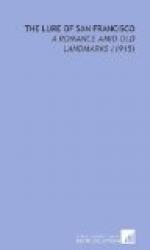“Yes, fully that,” I agreed. “A large part of the business section of San Francisco stands on made-land. The water along the shore, here at Montgomery street, was very shallow, and at the time of the gold rush, when seven or eight hundred vessels were waiting in the bay to discharge their freight and passengers, a corporation of energetic Americans built a long wharf from here to the deep water, where the ships were anchored. Look down Commercial Street to the Ferry Building and, instead of the houses on either side, imagine it open to the water. Then you will see Central Wharf as it was in ‘forty-nine.’”
“Central Wharf!” The name had caught his interest.
“Yes, it was called that from the one you have in Bost.”
“Bost?” he repeated, mystified. “Bost?”
“Yes, Bost!” I answered. “You called our, city ’Frisco, not five minutes ago, so why shouldn’t I—”
“I beg your pardon,” he said humbly. “I will never offend in that way again.”
“But the building of the wharves and the filling in of the waterfront belong to a later time and we are back in Spanish days. When Vancouver landed he tells us that he cast anchor within a small inlet surrounded by green hills, on which herds and cattle were grazing. Historians say that his ship lay about where the Ferry Building now stands and that the crew put off for the shore in small boats. This place was a waste of sand-dunes and chaparral but the Englishmen were refreshed by the cool waters of the arroyo and spent a pleasant morning shooting quail and grouse.”
“Quail, grouse and chaparral,” he repeated, as his eyes traveled up and down the solidly built blocks and rested on the pedestrians hurrying in and out of the buildings. “Let’s take a look at the bed of the arroyo.”
We paused at the corner and for a moment watched the car laboriously climb the Sacramento Street hill and disappear over the crest; then we turned for another look at the mass of buildings now resting on the solid ground which had taken the place of the shining waters of Yerba Buena Cove.
“It was about here,” I announced, “that the arroyo opened out into the Laguna Dulce, a little fresh water pool where Richardson’s Indians delighted to take a cold plunge on leaving their steaming temescal.”
“Richardson? Hardly a Spanish name!”
“No, but a Spaniard by naturalization and marriage. He was an Englishman who had come to the coast in the whaler ‘Orion,’ and being fascinated by the country and the carefree Spanish life, had married a lovely little senorita, the daughter of Lieutenant Martinez, later Comandante of the Presidio. Richardson settled on a ranch at Sausalito and in 1835, when Governor Figueroa decided to establish a commercial city on the shore of Yerba Buena Cove, he appointed as harbor master, this Englishman, who was already carrying on a small business with the Yankee skippers, and the future town was made a port of entry for all vessels trading up and down the coast. Richardson built the first house in the little settlement of Yerba Buena, afterwards San Francisco.”




